The SimBalance system is designed to tilt the head at an angle of 10-25⁰ while the user is sleeping on his/her regular bed. The system is comprised of three individual pillows, each with its own firmness, shape, and variable height. The combination of these three pillows provides optimal comfort for users, regardless of whether they sleep on the side or on the back. Equally important, the system aims to encourage users to change sleep positions throughout the night to simulate the head maneuver BPPV exercises. Each of the three pillows may also be used independently when the user does not require the use of the SimBalance pillow system for head positioning BPPV exercises.
The National Institute of Health (NIH) has supported studies that map out the orientation of the vestibular system and loose ear-rocks with respect to head positions. Some evidence appears to suggest the possibility that the completely horizontal position of the head may be the most vulnerable position for positional vertigo, as it allows loose ear-rocks to enter one of the semicircular canals. While the scientific community is still researching further in this area, clinicians have been recommending that BPPV patients should sleep on two stacked pillows or a recliner for at least a couple of days during or right after a dizziness episode. In addition to being an exercise aid for BPPV head maneuver exercises, the SimBalance pillow system has also been designed to take the guesswork out of the stacked-pillows practice, so that it will be comfortable and effective for long-term use. Furthermore, users with different physical builds can use the SimBalance pillow system to find different optimized configurations that are conducive to comfortable and effective head movements while sleeping.
The base pillow:
The visco-elastic (“memory”) foam block provides a soft yet supple base for the SimBalance pillow system. The base pillow has a slanting surface so that a user can choose the height most comfortable for him/her during the whole night’s rest. The firmness of the foam is specifically engineered to maintain the height of the support base but is also soft and contoured so that it does not cut into the back of the head. The base pillow utilizes a soft Velcro ® fabric that can be fastened onto the Velcro ® hooks on the main pillow. Once the optimal height and angle of the main pillow has been found, it can be locked into place.The head cannot “fall off” the pillow – which is often the case when two stacked pillows have slipped against each other during the night and lost their effective height. On its own, the base pillow may be used as a tall foam contoured pillow.
The Main pillow:
The regular-sized pillow, which is filled with firm hypoallergenic fiber clusters, conforms to the shape of the user’s head without distorting over time. When the main pillow rests on the base pillow, it defines the angle at which the head is inclined during sleep. When the user rolls over to the side-sleeping position, the overhanging ledgeof the main pillow curves over the front edge of the base pillow so
that shoulder width is accommodated – a little like the arm-rest of a big, comfortable couch. When the user rotates the head for the supine sleeping position, the neck region rests comfortably on the overhanging ledge of the main unit while the back of the head remains supported so that the head is still tilted. The main pillow on its own is a high-quality, firm pillow for everyday-use or when the head maneuver BPPV exercises are not needed. Like any conventional fiber-filled pillow, the main pillow should be regularly fluffed to maintain its effectiveness.
The supplemental pillow:
This is a memory-foam specialty pillow that can have a variety of uses. It may be placed under the base pillow to add height to the overall system, used to add support underneath the overhanging edge of the main unit and extra cushioning to the neck and shoulder regions, or placed under the spine for lumbar support. It can also be rolled up to form a bow-tie shape, the rounded part of which may be used as a “neck roll” on its own. The rolled-up structure has a firmness that is substantially higher than the memory foam itself, giving the user the option of extra-firm support if needed.
Which configuration is the best?
Many configurations for the SimBalance pillow system are possible. With the flexibility offered by three separate but interlocking units of different firmnesses, users can minimize stress and strain on the neck, spine and shoulders.
Based on users’ feedback, many of them petite women, we have added a section below for helping these ladies to get to a comfortable configuration faster.
The base pillow and main pillow provide the main functions of the system as an aid to head maneuver BPPV exercises. The supplemental pillow is used on an as-needed basis. There is no right or wrong way of using the three pillows, as long as the top of the head is elevated sufficiently, and the user does not feel any noticeable strain or stress on the neck, shoulders and back.
The mainpillow may rest in the middle over the base pillow, over the leading edge of the base support so that most of the main pillow is resting on the bed, or on the tall end of the base pillow to make the angle steeper. For example, for a user with especially broad shoulders, the tall end of the base pillow may be forward and aligned with the front edge of the main pillow to provide a tall support for the head.
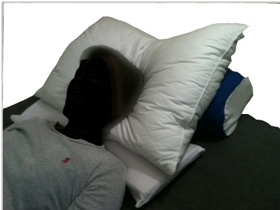
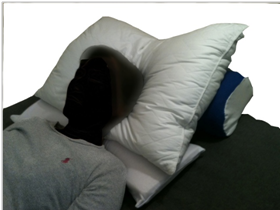
“LOW” positions for petite users (shorter than 5’4′ and under 120 lbs.)
This position lifts only the top of the head. It generates a large enough angle for head-up sleeping but does not strain the neck or spine excessively for physically petite users.
The main pillow is stacked on the slanting part of the base pillow. Most of the head of the user rests on the main pillow and only the top of the head is on the part on the blue base pillow.
For very petite users, it is possible to just use the blue base pillow.
The idea is to try to find the best configuration for you. Once you have, you will be sleeping with confidence that BPPV symptoms will be kept at bay!
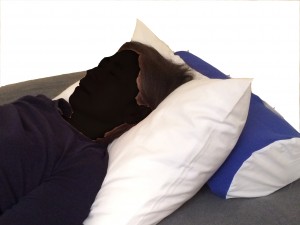
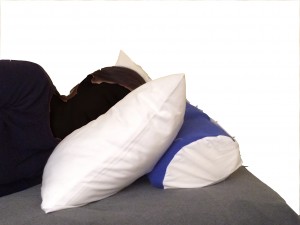
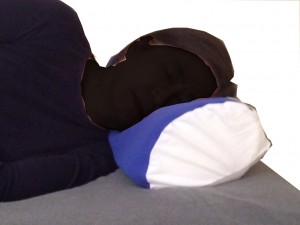
Here are some important points to note when beginning to use the SimBalance system:
- If excess strain or stress on the neck and spine is felt while using the SimBalance pillow system as a unit, STOP at once. Instead, use the main pillow by itself if some head elevation is desired, or use the supplemental pillow as a neck-roll for no head elevation, and place the base pillow directly behind the neck-roll to lift the top of the head off the bed.
- To adjust to the sleeping with the head tilted, place the base pillow far from the main pillow so that only the very end of the low end of the base pillow is touching the edge of the main unit. This way the head rests primarily on the main pillow with just the top of the head tilted a little. Gradually move the main pillow up the base unit to increase tilt.
- If some stiffness develops on a part of the neck or spine, change the configuration of the system slightly. This often eliminates the stiffness from that particular location in the body.
- If your mattress is extra firm, consider adding a mattress topper to your bed. 3-4″ memory foam toppers provide excellent support to the spine during head-up sleeping.
- If the SimBalance pillow system remains uncomfortable when used for the entire night of rest, use it to assist the head maneuver exercise as instructed by your doctor.
